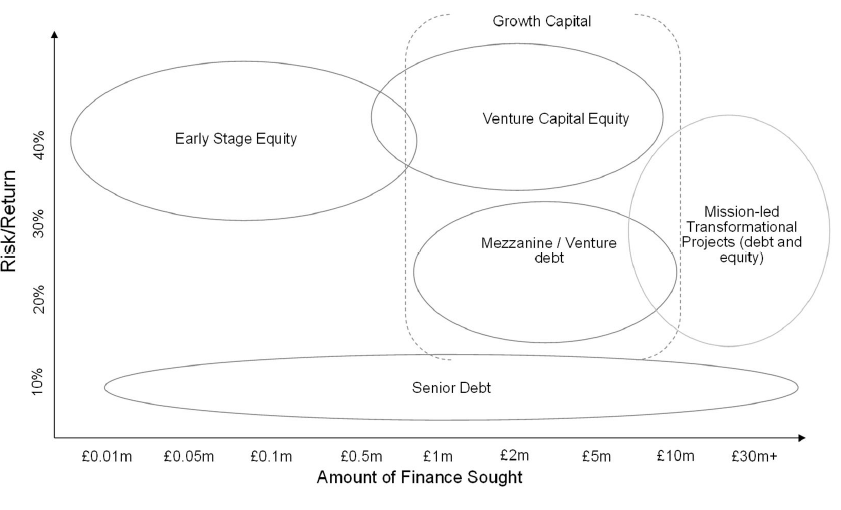Scottish National Investment Bank: implementation plan
This implementation plan provides recommendations on the establishment of a Scottish 'National Investment Bank'.
Appendix B Financial products
The risk and return profiles are considered below in the context of the Bank establishing a balanced portfolio.
Figure 9: Illustrative risk and return profile for financial products

These benchmarks can only be a guide. As the Bank develops its Business Plan and starts to invest, its management should adapt its strategy to the requirements of the market and to add value as well as making a return. In addition, while target returns can be established in the short-term, the actual return will not be apparent for several years, although there will be indications of the performance of both debt and equity.
An explanation of each investment and the expected returns are detailed below.
| Investment class Expected returns | |
|---|---|
| Early stage equity | Medium to long-term investment with return in the form of proceeds of selling the equity on exit. Overall return will be net of the Bank’s costs of running the equity investment programme (eg, investment managers, commercial advisors) and the costs of investment failure (as risk capital, failure risk for this investment category is relatively high). Target return for each investment in the region of 30-50%, in order to generate an overall blended target return for the investment class of 10%, being investment returns net of running and failure costs. The British Private Equity and Venture Capital Association (" BVCA") benchmarking [23] indicates an average range IRR of 9.8% from this investment class. |
| Mezzanine finance | Medium-term investment with return in the form of interest, and, often at the end of the term, repayment of the principal amount. Interest will either be capitalised or paid in cash during the period of the loan, or a combination of both. A variable share in the business upside may also be received through either an equity warrant or a profit/growth levy or redemption premium equating to a percentage of the loan amount. Overall return will be net of the Bank’s costs and the costs of investment failure (whilst mezzanine debt has priority over equity, it is subordinate to senior debt). The BBB identified a target return in the region of 8-20% [24] may be appropriate. This would accommodate an overall blended target return for the investment class of 10%, being investment returns net of running and failure costs. |
| Venture capital | Short to medium-term type of private equity, provided to small, early-stage, emerging firms that are deemed to have high growth potential or have demonstrated high growth to date. Venture capital generally comes from venture fund managers, high net worth individuals, investment banks and any other financial institutions. The early stage nature of these investments are often inherently risky which is reflected in the often high rates of return sought on investments. Levels of returns and losses are akin to early stage equity outlined above. |
| Subordinated debt | Short to medium-term investment with return in the form of interest and, often at the end of the term, repayment of the principal amount. Overall return will be net of the Bank’s costs and the costs of investment failure (has priority over equity, but is subordinate to senior debt). Coupon price will reflect the risk of each specific investment. Target return 10-15% to generate a blended target return of 10%, being investment returns net of running and failure costs. |
| Senior debt | Short to long-term investment with return in the form of interest and, more than likely a combination of regular and one off payments at the end of the term, to repay the original principal amount. Low margin investment, so risk tolerance is also low. The Bank would aim to limit any failures to around 2% to avoid the investment class making a loss overall. |
Contact
There is a problem
Thanks for your feedback